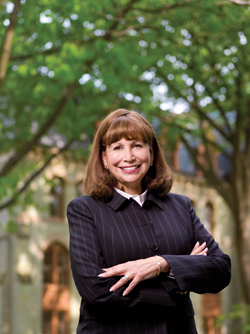What We Can Achieve Together
Among the many wonderful moments from the two days of inauguration ceremonies at the end of January, I will particularly treasure the experience of standing in Riverside Church and looking out at the combined might of Teachers College-'"our faculty, staff, students, alumni, trustees and many friends-'"and thinking about the even more amazing potential contained within this institution.
We are home to so many diversely talented, brilliant, experienced, caring and committed people from so many different backgrounds and walks of life, working across such a great breadth of disciplines. And as a professional school, we directly apply all of those wonderful attributes not merely to the generation of new knowledge, but to helping people and improving lives.
As I said in my speech in
But people in academia tend to work independently. Each of us is passionate about our work and believes that what we, personally, are doing at any given moment is of the utmost importance. With TC's legacy, then, comes a challenge. How can we ensure that the collective strength of the College is more than just a colorful celebration made at symbolic occasions such as an inauguration or convocation? How can we pool our resources across departments, programs and functions so that the whole is greater than the sum of our parts? More broadly still, how can we achieve that kind of synergy with people in other institutions and organizations? And what would the result look like if we did?
On striking example can be found on the front page of this publication. In work that has been widely reported in the media, a team led by TC Professor Hank Levin has documented tax-payer savings that could be achieved by boosting the country's high school graduation rate. More specifically, the study quantifies the impact of a higher graduation rate on costs associated with crime, welfare, tax revenue and public health. It shows, in concrete terms, how up-front investment in education can pay greater dividends down the road.
As much as the richness of the study's data, the broad expertise of the researchers stamps it as one that simply cannot be ignored by legislators and policymakers. Hank Levin founded and was the initial guiding force behind Accelerated Schools, a massive nationwide reform program designed to bring disadvantaged youngsters into the educational mainstream by the end of elementary school. Peter Muennig of Columbia's Mailman School of Health was trained as a physician; the work of Cecilia Rouse of Princeton ranges from classic cost-benefit analyses to evaluations of discrimination in symphony orchestras and the use of computers in schools, and CUNY's Clive Belfield performed some of the critical economic analysis in the most recent evaluation of the famed Perry Preschool Project.
We should all work towards a multidisciplinary focus and approach. For each of us, it starts simply with talking to one's colleagues around the College to learn what they do. What begins as a conversation could end up as collaboration on a grand scale. And that would be real cause for celebration.
Published Friday, Feb. 23, 2007
